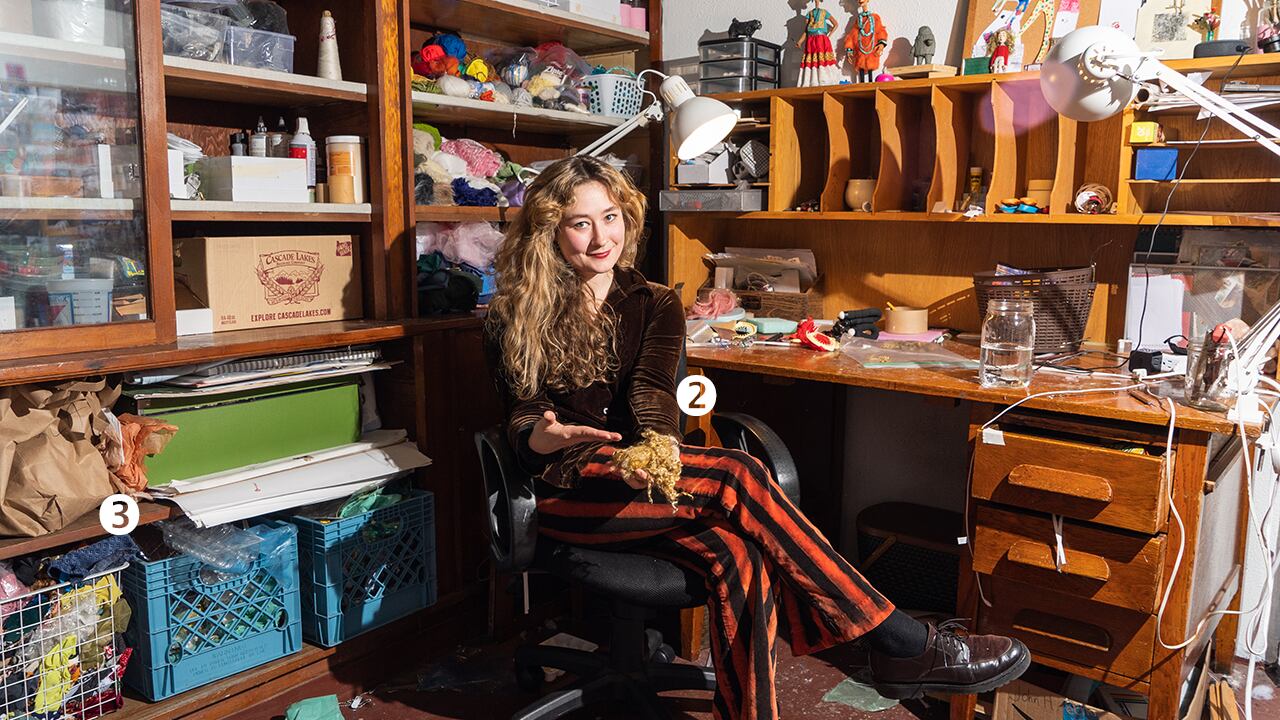Katy Strutz doesn't want to be defined by a single style.
As an animator and a puppet maker, she likes invoking disparate influences, whether that means being inspired by the Ziegfeld Follies, '80s movies or Henri Matisse. "I try to take it project by project, I guess," she says. "I'll always have something that I'm trying to emulate, but it ends up looking totally different when it goes through my brain."
Strutz is known for her work at Laika, ShadowMachine and Hornet. Yet the core of her creativity is a studio in the basement of her Portland home, a quirky wonderland overflowing with hair, collages, recyclables and character designs.
With contagious wonderment, Strutz—who is currently working as a character sculptor on director Guillermo del Toro's Pinocchio—revealed some of the secrets of her happily cluttered workspace during a Zoom conversation. "Nobody comes to [my studio] but me," she says. "I think it's beautiful, but it's not necessarily meant to be anything but what I need it to be."

1. Iris Apfel and Frida Kahlo Puppets
After Strutz posted a picture of an Iris Apfel puppet that she created on Instagram, it was reposted by the fashion icon herself. The Apfel puppet now sits on Strutz's desk next to a tiny version of one of her other inspirations, Frida Kahlo. "Just as a person and as an artist, I think she was really incredible," says Strutz. "Really resilient, of course, and she wore incredible textiles, which were fun to re-create."
Not far from Apfel and Kahlo is an aluminum wire sculpture that was given to Strutz by Disney veteran Kent Melton. "He was working at Laika when I first started, and I went upstairs to introduce myself to him, and I was hoping that we'd really hit it off and he'd be like, 'What a cool girl, I want her to be my friend,' and think I was really fun and impressive," Strutz says. "And it's one of the few times in my life when I've just totally frozen and just been like, 'Hi.'"
2. Hair
Strutz is a hair connoisseur of the highest order. "I'm always very proud of my bins of hair—doll hair, dyed goat hair, people hair, plastic hair, animal furs," she says. "Mohair, which is from goats, is definitely my favorite. I'll usually just buy it on Etsy. Mohair is what I used to make miniature Katy's hair. It was from a goat, and I dyed it with fabric dye."
"Miniature Katy" is Strutz's puppet avatar. She has been photographed everywhere from California to North Carolina—and always rocks a cloud of billowing blond curls that looks strikingly like Strutz's own coiffure.
3. Recyclables
Mundane but malleable objects—like mesh bags that once held oranges and assorted pieces of plastic—are a fixture of Strutz's studio. "My friends know that I like to collect these recyclables and plastics," she says. "If you need to make a futuristic environment, like I've done sometimes, you start to use them as architectural shapes or things that could be part of a car or a building."
Strutz has also turned a pink-and-white dollhouse she found on a street in her neighborhood into a storage space for foam. "I like the idea of making a dollhouse, and so finding an existing structure was really exciting," she says. "So we'll see if I do anything with it or if I just end up giving it to an actual child who might appreciate it more."
4. Concrete Floor
The floor of Strutz's basement isn't just a surface to stand on—it's a stage. "If you're shooting an animation over a long period of time on a wooden floor or something else that can, even on a microscopic level, swell or bend, you can end up having your stop-motion stage move around," she says. "It's one of the things that you would never think about until you're halfway through an animation and you're like, 'Wait a minute, why is my stage moving?'"

5. Monster Workspace
Strutz is collaborating on a short film about monsters and prepackaged food with Jeff Riley and Thibault Leclercq. An entire section of her studio has been designed as a "monster workspace"—and it's filled with designs for strange yet cuddly-looking creatures. One of the highlights of the monster workspace is a pair of gray monster feet. "They're like turtle feet with a little bit of extra pointiness," Strutz says. "I'll probably cast them in either latex or silicone." She has also cobbled together character collages from old issues of National Geographic, after "either ripping things out or cutting them out if there was a larger patch of color or texture on a page or something that looked like a complete shape."
The monster workspace is an embodiment of Strutz's beautifully tactile approach to animation. "I think that's why stop-motion and fabrication work well for me," she says. "It's always about assembly—starting by collecting the materials and then figuring out how to combine them in a way that creates a functional, engineered tiny machine."
Puppet Maker Katy Strutz's Basement Studio Is Full of Miniature Monsters and Multiple Bins of Hair
At Home, Filmmaker Alberta Poon Is as Much of a "Mood-Slash-Light Psycho" as She Is on Set
Jazz Musician Ezra Weiss Has Gone From Leading Big Bands to Playing Alone in His Home
